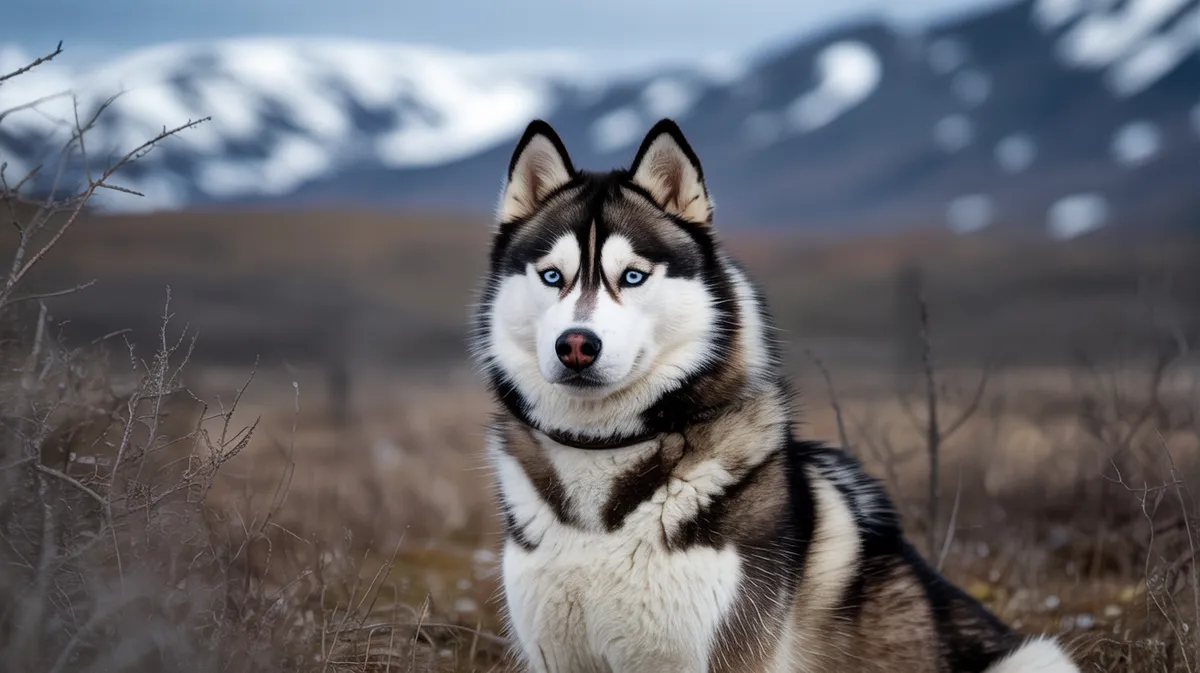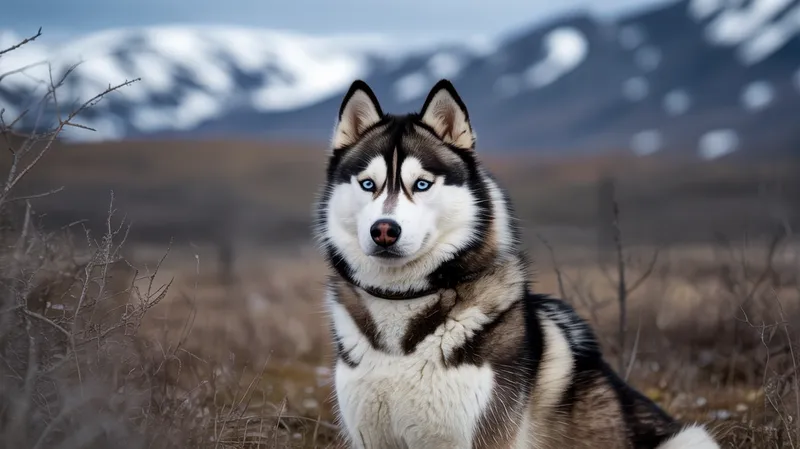
Siberian Husky
Canis lupus familiaris

Meet the Siberian Husky
The Siberian Husky is a medium-sized working dog breed renowned for its striking appearance, featuring a thick double coat, erect triangular ears, and distinctive markings, often with piercing blue or multicolored eyes. Originally bred by the Chukchi people of northeastern Siberia, these dogs were developed as endurance sled dogs, capable of pulling light loads over vast frozen distances. Siberian Huskies are known for their intelligence, high energy, friendly demeanor, and strong pack instincts, making them excellent companions but challenging for inexperienced owners. They are highly vocal, rarely bark, and are famous for their 'talking' or howling abilities.
Classification
Mammal
Habitat
Arctic and subarctic tundra
Diet
Omnivore
Lifespan
12-15 years
Conservation
Least Concern
Weight
16-27 kg (35-60 lbs)
📖Fascinating Facts
Endurance Champions
Bred by the Chukchi people, Siberian Huskies were designed to pull sleds over long distances in extreme Arctic conditions, covering remarkable distances each day.
Striking Eyes
Siberian Huskies can have blue, brown, or even one of each (heterochromia), which adds to their captivating appearance.
Cold-Weather Adapted
Their dense double coat provides insulation against freezing temperatures, and their bushy tails can be used to cover their faces while sleeping in the snow.
📋Detailed Description
The Siberian Husky is a medium-sized, athletic dog breed with a compact, well-proportioned body built for endurance and efficiency. Males typically weigh 20–27 kg (45–60 lb) and stand 53–60 cm (21–23.5 in) at the shoulder, while females are slightly smaller. Their dense double coat consists of a soft, insulating undercoat and a straight, weather-resistant outer coat, allowing them to withstand temperatures as low as -50°C (-58°F). The breed is distinguished by striking facial masks, erect triangular ears, and expressive almond-shaped eyes, which may be blue, brown, amber, or heterochromatic. Siberian Huskies have a fox-like brush tail often carried in a sickle curve over the back. Anatomically, they possess a deep chest, strong back, and well-developed muscles, facilitating efficient movement over snow. Their feet are oval and well-furred, with tough pads to provide traction and insulation. Huskies are renowned for their stamina, agility, and ability to travel long distances at moderate speeds, traits honed by centuries of selective breeding for sled work. Socially, they are highly pack-oriented, displaying complex communication through body language, vocalizations, and facial expressions. Their intelligence and problem-solving abilities are notable, though they can be independent and stubborn, requiring consistent training and mental stimulation.
💡 Did you know?
Unlike many dog breeds, Siberian Huskies have a natural resistance to cold thanks to their dense double coat, allowing them to comfortably sleep in snow.
🔬Research & Sources
Wikipedia Summary
The Siberian Husky is a breed of medium-sized working sled dog. The breed belongs to the Spitz genetic family. It is recognizable by its thickly furred double coat, erect triangular ears, and distinctive markings, and is smaller than the similar-looking Alaskan Malamute.
Last Modified: 5/24/2025
🎭Behavior & Social Structure
Siberian Huskies are highly energetic, requiring significant daily exercise and mental engagement. They exhibit strong exploratory and escape tendencies, often digging or climbing to satisfy their curiosity. As pack animals, they thrive in social environments and typically get along well with other dogs, though their high prey drive can make them unreliable with small animals. Huskies are known for their minimal barking but are highly vocal, expressing themselves through howls, 'talking,' and a range of other sounds. In working contexts, they display coordinated team behavior, responding to subtle cues from musher and fellow dogs. Feeding behavior is omnivorous, though they have a relatively efficient metabolism, adapted to sparse Arctic diets. Daily routines often include bursts of intense activity interspersed with periods of rest. They are intelligent problem-solvers but can be willful, making consistent, positive reinforcement training essential.
👶Reproduction & Life Cycle
Siberian Huskies reach sexual maturity between 6 and 12 months, though breeding is typically recommended after 2 years of age. Females come into estrus (heat) once or twice a year, with a gestation period averaging 63 days. Litters usually consist of 4–8 puppies. Both parents may exhibit some degree of parental care, but the female is primarily responsible for nursing and nurturing the pups. Puppies are born blind and deaf, opening their eyes at around 10–14 days. Socialization and early exposure to humans and other animals are critical for healthy behavioral development. Breeding seasonality is less pronounced in domestic settings but may be influenced by photoperiod and environmental conditions in northern latitudes.
🛡️Adaptations & Survival
Siberian Huskies possess a suite of adaptations for Arctic survival. Their double coat provides exceptional insulation, while the outer guard hairs repel snow and moisture. The breed's metabolic efficiency allows them to perform strenuous work on limited food, a trait selected by the Chukchi people. Their almond-shaped eyes reduce snow glare, and heavily furred, compact feet minimize heat loss and provide traction on ice. The sickle-shaped tail can be curled over the nose for warmth during rest. Behaviorally, their social structure and cooperative instincts enhance group survival and sled team performance. Huskies also have a high tolerance for cold but are less suited for hot climates, being prone to heat stress.
📚Research Sources
🎨Cultural Significance
The Siberian Husky holds a prominent place in Arctic and subarctic cultures, especially among the Chukchi people, who developed the breed for transportation and companionship. They gained international fame during the 1925 'Serum Run' to Nome, Alaska, where teams of Huskies delivered diphtheria antitoxin across treacherous terrain, inspiring the annual Iditarod sled dog race. The breed symbolizes endurance, teamwork, and resilience in popular culture. Huskies frequently appear in literature, film, and as mascots, embodying the spirit of the North. They are also valued for their role in search-and-rescue, therapy, and as family companions.
🔬Recent Research & Discoveries
Recent genetic studies have clarified the Siberian Husky's close relationship with ancient Arctic sled dogs and their divergence from other spitz breeds. Research into their metabolic adaptations has provided insights into endurance physiology and cold tolerance. Behavioral studies highlight their advanced social cognition and communication skills. Ongoing work investigates breed-specific health issues, such as inherited eye diseases and autoimmune disorders. Studies on their role in human-animal interaction have shown positive effects on human well-being, particularly in therapy and service contexts. Advances in canine genomics continue to shed light on the breed's unique evolutionary history.
🎥Wildlife Videos

The Arctic Adventurer: Unveiling the Siberian Husky’s Spirit
Uncover the incredible story of the Siberian Husky, the ultimate Arctic adventurer! From their origins with the Chukchi people to ...
The Story of Animals

Discover the Fascinating Histories of Arctic Dogs
Join us on a captivating journey into the fascinating histories of Arctic dogs with our latest video, "Tales of Arctic Dogs: An ...
HuskyHub

Top Animal Videos of Husky Channel
animalsvideo #anmals #husky Top Animal Videos of Husky Channel.
Husky

Raising Huskies in Alaska | Man, Woman, Dog
Twin sisters, Anna and Kristy Berington, train and raise multiple packs of huskies to traverse the rugged Alaskan terrain.
Nat Geo Animals

10 Things You Didn’t Know About the Siberian Husky
The Siberian Husky is probably one of the most popular Nordic dogs in the world. While there's nothing compared to spending ...
AnimalWised
🌍Habitat Information
The Siberian Husky typically inhabits Arctic and subarctic tundra environments. Siberian Huskys have adapted to their environments with specialized features and behaviors.
Primary Habitat:
Arctic and subarctic tundra
More detailed habitat information will be available soon.
🛡️Conservation Status
The Siberian Husky is currently classified as Least Concern. Conservation efforts are crucial for preserving this species for future generations.
Common Threats:
- 🏠Habitat loss and fragmentation
- 🌡️Climate change impacts
- 🎯Hunting and poaching
- 🏭Human-wildlife conflict
⚠️Threats & Conservation Challenges
As a domestic breed, Siberian Huskies are not threatened in the wild, and their global population is stable. However, challenges include irresponsible breeding, abandonment due to their high energy and exercise needs, and health issues such as hip dysplasia, eye disorders (e.g., cataracts, progressive retinal atrophy), and autoimmune conditions. In some regions, crossbreeding with wolves or other breeds has led to concerns about temperament and health. Climate change and urbanization have reduced traditional sled dog roles, though recreational mushing and companion animal status remain strong. Education on breed-specific needs is vital to prevent welfare issues.
🔬Scientific Classification
Scientific Name
Canis lupus familiaris
Classification Hierarchy
🔍 About Taxonomic Classification
Taxonomic classification is a hierarchical system used by scientists to classify and organize living organisms based on shared characteristics and evolutionary relationships.
The system moves from broad categories (Kingdom) to increasingly specific ones, with each animal's scientific name typically consisting of its Genus and species.
📝Community Notes
Share your observations and insights about the Siberian Husky with our community of wildlife enthusiasts.
Join Our Community
Sign in to share your observations and connect with fellow wildlife enthusiasts.
Sign In to ContributeNo community notes yet
Be the first to share your observations about the Siberian Husky!
Explore Siberian Husky
Select a tab above to learn more about this amazing animal.
📸Photo Gallery
No photos available for this animal yet.
🌟Discover More Wildlife
Continue your journey of discovery with more fascinating animals from our database
